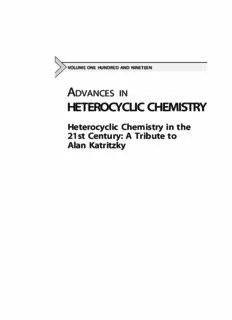
Heterocyclic Chemistry in the 21st Century A Tribute to Alan Katritzky PDF
Preview Heterocyclic Chemistry in the 21st Century A Tribute to Alan Katritzky
VOLUMEONEHUNDREDANDNINETEEN A DVANCES IN HETEROCYCLIC CHEMISTRY Heterocyclic Chemistry in the 21st Century: A Tribute to Alan Katritzky EDITORIAL ADVISORY BOARD A. T. Balaban Galveston, Texas, United States of America A. J. Boulton Norwich, United Kingdom M. Brimble Auckland, New Zealand D. L. Comins Raleigh, North Carolina, United States of America J. Cossy Paris, France J. A. Joule Manchester, United Kingdom V. I. Minkin Rostov-on-Don, Russia B. U. W. Maes Antwerp, Belgium A. Padwa Atlanta, Georgia, United States of America V. Snieckus Kingston, Ontario, Canada B. Stanovnik Ljubljana, Slovenia C. V. Stevens Ghent, Belgium J. A. Zoltewicz Gainesville, Florida, United States of America VOLUME ONEHUNDREDAND NINETEEN A DVANCES IN HETEROCYCLIC CHEMISTRY Heterocyclic Chemistry in the 21st Century: A Tribute to Alan Katritzky Editors ERIC F. V. SCRIVEN Department of Chemistry, University of Florida, Gainesville, FL, USA CHRISTOPHER A. RAMSDEN Lennard-Jones Laboratories, Keele University, Staffordshire, United Kingdom AMSTERDAM(cid:129)BOSTON(cid:129)HEIDELBERG(cid:129)LONDON NEWYORK(cid:129)OXFORD(cid:129)PARIS(cid:129)SANDIEGO SANFRANCISCO(cid:129)SINGAPORE(cid:129)SYDNEY(cid:129)TOKYO AcademicPressisanimprintofElsevier AcademicPressisanimprintofElsevier 50HampshireStreet,5thFloor,Cambridge,MA02139,USA 525BStreet,Suite1800,SanDiego,CA92101-4495,USA 125LondonWall,LondonEC2Y5AS,UK TheBoulevard,LangfordLane,Kidlington,OxfordOX51GB,UK Firstedition2016 Copyright©2016ElsevierInc.Allrightsreserved. Nopartofthispublicationmaybereproducedortransmittedinanyformorbyanymeans,electronicor mechanical,includingphotocopying,recording,oranyinformationstorageandretrievalsystem,without permissioninwritingfromthepublisher.Detailsonhowtoseekpermission,furtherinformationabout thePublisher’spermissionspoliciesandourarrangementswithorganizationssuchastheCopyright ClearanceCenterandtheCopyrightLicensingAgency,canbefoundatourwebsite:www.elsevier.com/ permissions. ThisbookandtheindividualcontributionscontainedinitareprotectedundercopyrightbythePublisher (otherthanasmaybenotedherein). Notices Knowledgeandbestpracticeinthisfieldareconstantlychanging.Asnewresearchandexperience broadenourunderstanding,changesinresearchmethods,professionalpractices,ormedicaltreatment maybecomenecessary. Practitionersandresearchersmustalwaysrelyontheirownexperienceandknowledgeinevaluatingand usinganyinformation,methods,compounds,orexperimentsdescribedherein.Inusingsuchinformation ormethodstheyshouldbemindfuloftheirownsafetyandthesafetyofothers,includingpartiesfor whomtheyhaveaprofessionalresponsibility. Tothefullestextentofthelaw,neitherthePublishernortheauthors,contributors,oreditors,assumeany liabilityforanyinjuryand/ordamagetopersonsorpropertyasamatterofproductsliability,negligence orotherwise,orfromanyuseoroperationofanymethods,products,instructions,orideascontainedin thematerialherein. ISBN:978-0-12-804695-1 ISSN:0065-2725 ForinformationonallAcademicPresspublicationsvisitour websiteathttps://www.elsevier.com Publisher:ZoeKruze AcquisitionEditor:PoppyGarraway EditorialProjectManager:ShellieBryant ProductionProjectManager:SuryaNarayananJayachandran Designer:MarkRogers TypesetbyTNQBooksandJournals CONTRIBUTORS ScottBur DepartmentofChemistry,GustavusAdolphusCollege,St.Peter,MN,USA ChristosP.Constantinides DepartmentofChemistry,NorthCarolinaStateUniversity,Raleigh,NC,USA JanineCossy LaboratoiredeChimieOrganique,InstituteofChemistry,BiologyandInnovation(CBI), UMR8231,ESPCIParis/CNRS/PSL*ResearchUniversity,Paris,France AmandineGuérinot LaboratoiredeChimieOrganique,InstituteofChemistry,BiologyandInnovation(CBI), UMR8231,ESPCIParis/CNRS/PSL*ResearchUniversity,Paris,France C.DennisHall DepartmentofChemistry,UniversityofFlorida,Gainesville,FL,USA JohnA.Joule TheSchoolofChemistry,TheUniversityofManchester,Manchester,UK PanayiotisA.Koutentis DepartmentofChemistry,UniversityofCyprus,Nicosia,Cyprus MatthiasM.A.Moens SynBioCResearchGroup,DepartmentofSustainableOrganicChemistryandTechnology, FacultyofBioscienceEngineering,GhentUniversity,Ghent,Belgium MarineMovsisyan SynBioCResearchGroup,DepartmentofSustainableOrganicChemistryandTechnology, FacultyofBioscienceEngineering,GhentUniversity,Ghent,Belgium ChristianF.Otto ClausthalUniversityofTechnology,Clausthal-Zellerfeld,Germany AlbertPadwa DepartmentofChemistry,EmoryUniversity,Atlanta,GA,USA SivaS.Panda DepartmentofChemistryandPhysics,AugustaUniversity,Augusta,GA,USA AndreasSchmidt ClausthalUniversityofTechnology,Clausthal-Zellerfeld,Germany BrankoStanovnik FacultyofChemistryandChemicalTechnology,UniversityofLjubljana,Ljubljana,Slovenia ChristianV.Stevens SynBioCResearchGroup,DepartmentofSustainableOrganicChemistryandTechnology, FacultyofBioscienceEngineering,GhentUniversity,Ghent,Belgium j ix x Contributors SaschaWiechmann ClausthalUniversityofTechnology,Clausthal-Zellerfeld,Germany ViktorV.Zhdankin DepartmentofChemistryandBiochemistry,UniversityofMinnesotaDuluth,Duluth, MN,USA PREFACE A short tribute to Alan Katritzky, highlighting aspects of his major work in heterocyclic chemistry (structure, mechanism, theory, QSAR, synthetic methods, applications, and the review literature) appeared in Volume 113 ofAdvancesinHeterocyclicChemistry.Forover50years,Alanwasatthefore- frontofadvancesinandapplicationsofheterocyclicchemistry.Heinitiated the publication of Advances in Heterocyclic Chemistry in 1963 and personally commissioned and edited 112 volumes. When we considered what would be a fitting tribute to his contribution, we posed the question, as we felt Alan would have, “What is happening now, and what next?” In response tothisquestion,wehavebeenfortunatetoreceive27chaptersfromleaders currently involved in heterocyclic chemistry and its applications. These chapters cover the latest advances in the areas mentioned above together with a broad scope of new developments. Thefirstvolumeofthisthree-volumetributecontainsninechapters.In Chapter 1, Dennis Hall (University of Florida) and Siva Panda (Augusta University) highlight the important contribution of Alan Katritzky’s workonsynthetic application of 1H-benzotriazole as ahalogen surrogate. In Chapter 2, Marine Movsisyan, Matthias Moens, and Christian Stevens (Ghent University) describe the use of microreactors and illustrate their applications and advantages using selected examples of the flow synthesis of heterocycles. The structure and synthetic applications of hypervalent heterocyclic derivatives of nonmetal main-group elements (B, Si, P, S, Se,Br,andI)arethesubjectofChapter3byViktorZhdankin(University of Minnesota Duluth). The next two chapters cover new aspects of heterocyclic natural products. In Chapter 4, John Joule (The University of Manchester) highlights novel aspects of natural products containing nitrogen heterocycles that have been revealed in the period 1990–2015. Chapter 5 by Janine Cossy and Amandine Guérinot (ESPCI Paris/ CNRS/PSL* Research University) describes advances during the period 1990–2015 in the synthesis of natural products containing oxygen heterocycles. The generationof three-to eight-memberedN-heterocyclic carbenes is reviewed by Andreas Schmidt, Sascha Wiechmann and Christian F. Otto (ClausthalUniversityofTechnology)inChapter6.ChristosConstantinides (North Carolina State University) and Panayiotis A. Koutentis (University of Cyprus) review recent developments in the synthesis and applications j xi xii Preface ofstableN-andN/S-richheterocyclicradicalsinChapter7.Newdevelop- mentsinheterocyclictautomerismwithparticularreferencetodesmotropes, carbenes, and betaines are reviewed in Chapter 8 by Branko Stanovnik (University of Ljubljana). The volume concludes with a review by Albert Padwa (Emory University) and Scott Bur (Gustavus Adolphus College) of recentadvancesintheuseof1,3-dipolarcycloadditionsinalkaloidsynthesis. Chris Ramsden and Eric Scriven April, 2016 CHAPTERONE The Benzotriazole Story C. Dennis Hall1,*, Siva S. Panda2 1DepartmentofChemistry,UniversityofFlorida,Gainesville,FL,USA 2DepartmentofChemistryandPhysics,AugustaUniversity,Augusta,GA,USA *Correspondingauthor:E-mail:[email protected] Contents 1. 1H-BenzotriazoleasaSyntheticTool 3 2. 1H-BenzotriazoleintheSynthesisofHeterocycles 5 3. Acylation,Aroylation,andHeteroaroylationbyBtTechnology 7 4. Alkylations,Heteroalkylations,andBt-StabilizedCarbanions 9 4.1 AlkylationsandHeteroalkylations 9 4.2 Bt-StabilizedCarbanions 10 5. RearrangementsofBenzotriazoleDerivatives 10 6. BenzotriazoleintheSynthesisofPeptidesandIsopeptides 11 7. BenzotriazoleintheSynthesisofAminoAcid/PeptideBioconjugates 12 8. NativeChemicalLigationUsingBenzotriazoleChemistry 16 9. BenzotriazoleintheSynthesisofCyclicPeptidesandCyclicPeptidomimetics 18 10. BenzotriazoleintheSynthesisofPeptidomimetics 20 11. Conclusion 20 References 20 Abstract Theutilityof1H-benzotriazoleasahalogensurrogateinacylation,aroylation,andalkyl- ationreactionsisreviewedtogetherwithitsapplicationtothesynthesisofheterocycles, peptides,isopeptides,cyclicpeptides,peptidomimetics,andpeptideconjugates. Keywords: Amino acids; Benzotriazole; Conjugates; Halogen surrogate; Heterocycles; Peptides;Synthesis When Alan Katritzky died on February 10, 2014, over 2170 research papers alone were credited to his name, 636 of which dealt with various aspects ofbenzotriazole (Bt)chemistry.Sincehisdeath,another 40þpapersincor- porating someaspects of Bt technology have appeared or are due to appear in the literature. This review therefore seeks to do justice to 25years of intensiveresearchbyfocusingonthehighlightsofARK’sBtcontributions. AdvancesinHeterocyclicChemistry,Volume119 ISSN0065-2725 ©2016ElsevierInc. j 1 http://dx.doi.org/10.1016/bs.aihch.2016.01.001 Allrightsreserved. 2 C.DennisHallandSivaS.Panda ThisaspectofAlan’sworkbeganin1990andtothisdaythereisanotice pinned to the wall of the Katritzky Conference Room at the University of Floridawhich urgesus torememberthat “3months ofworkin thelabora- torycansaveyou3hinthelibrary”(orinmodernparlance,savesometime on the Internet). True to form, Alan began the benzotriazole phase of his work by a review entitled, “Benzotriazole, a novel synthetic auxiliary” (1991T2683). Subsequent years saw reviews appearing on further aspects of benzotriazole as a synthetic tool (1998CRV409) (1999JHC1501, 2003CEJ4586), on the use of benzotriazole in heterocyclic synthesis (1996 T15031, 1998JHC1123, 2010CRV1564, 2011CRV7063), N-acylbenzo- triazoles (2005SL1656), Bt-mediated alkylation (2005T2555), Bt-stabilized carbanions (1994AA31), heterocyclic rearrangements (1993H483), bio- conjugates (2009ARK248), and finally the synthesis of peptides (2009 SL2392)andpeptideconjugates(2013AA43).Thelasttwotopicsrepresent the culmination and zenith of a sustained effort in a rich field which gave Alan a great deal of satisfaction. Sowhatisitthatgivesbenzotriazolesuchubiquitousutility?Toanswer thatrhetoricalquestionwemustfirstlookatthestructureandpropertiesof benzotriazole(1ab)itself(Scheme1).Thequinonoidform(1b)islessstable than the benzenoid tautomer (by ca. 9.5kcal/mol) so most derivatives of Bt appear as the (N)-1 isomer although the proportion of (N)-2 isomer increases with the steric bulk of the N-substituents (1990JOC5683, 1990JCS(P2)2059). The molecule is a weak acid (pKa 8.2) but is also a very weak base (pKa<0) and consequently is soluble in aqueous sodium carbonate or 1MHCl,thusaffordingtwopotentialmethodsofseparationfromreaction mixtures. Themolecule is both electron attracting,thusstabilizingcarban- ions, and electron donating giving rise to acyl, aroyl, phosphonyl, and sulfonylderivativesofsyntheticutility(videinfra).Mostimportantly,how- ever,benzotriazolebehavesasaleavinggroupsurrogateforhalogenandin thisrespectaffordsthedistinctadvantagesofbenzotriazolederivativesbeing (1) easy to prepare, (2) stable to air and moisture over long periods of time but, (3) sufficiently reactive to duplicate most reactions of their halogen analogs. Scheme1
Description: